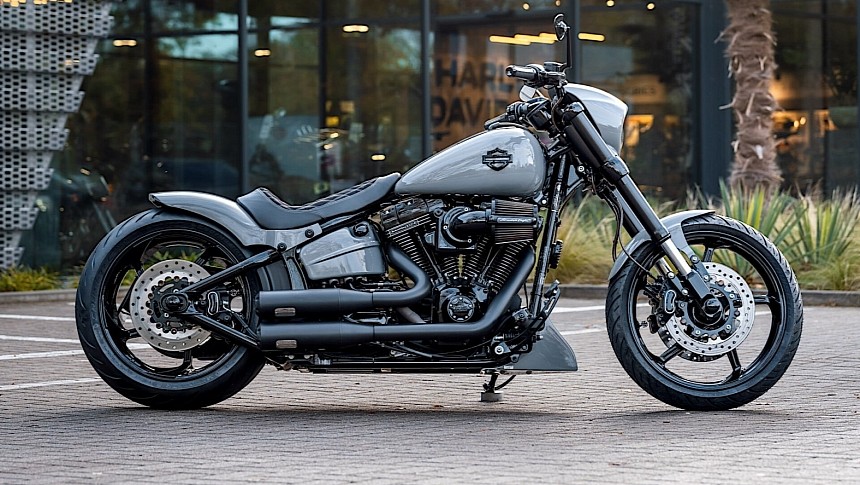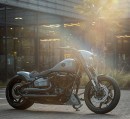Harley's Custom Vehicles Operations (CVO) came back in the spotlight with a bang earlier in June, after it released two new touring models, the 2023 Street Glide and 2023 Road Glide. Naturally, both are still the talk of the industry, especially given how they bring to the table a brand new member of the Milwaukee-Eight engine family, and a host of features and tech never before seen on Harley motorcycles.
It's safe to assume custom garages around the world can't wait to get their hands on the two models too, hoping to tweak them even further and add their own personal touches. They'll have to do a bit of waiting before doing that, though, as the new CVOs won't become available until next month.
Until then, German garage Thunderbike decided to give us a glimpse of what it can do to CVO machines by releasing something called the Grey Buster. It's not a new CVO bike, but a 2016 CVO Pro Street Breakout, and still a sight to behold, despite its age.
Now, Thunderbike admits that “when you get your hands on a CVO Harley, it is best to preserve, protect and keep it in its original condition,” but blames the unnamed owner for the conversion, saying he “wanted to have the bike rebuilt to his specifications.”
If we are to be honest, the changes made are not that extensive, but they are effective nonetheless. Just around 18 major parts were fitted on the ride, including small bits like the tank and seat covers, turn signals, and mirrors.
The most noticeable difference from a stock CVO Breakout, at the front, is the fitting of a new chin fairing and a new mask for the headlight. The opposite end is where a large custom rear fender with hidden integrated tail lights is located.
A quick look at the ride will make it obvious the rear has been lowered (unclear by how much), so now the custom seat is closer to the ground.
Mechanically, the bike still packs the Screamin’ Eagle Twin Cam engine in its frame, breathing through a an aftermarket exhaust system of undisclosed make. A Muller hydro clutch is included for better gearing.
When all mechanical and aesthetical work on the bike was completed, the Breakout was drowned in a color called Gunship Grey, highlighted here and there by touches of black.
Thunderbike says the CVO was just 4,300 km (2,672 miles) old when it arrived in its shop, and given how it just rolled out the stands in this new form, it probably still shows about the same mileage. As for the cost of the build, we only know how much the extra parts added on the build cost, and that would be just 3,800 euros ($4,100). For reference, when Harley introduced the CVO Breakout in 2016 it asked over $25,000 for it.
Until then, German garage Thunderbike decided to give us a glimpse of what it can do to CVO machines by releasing something called the Grey Buster. It's not a new CVO bike, but a 2016 CVO Pro Street Breakout, and still a sight to behold, despite its age.
Now, Thunderbike admits that “when you get your hands on a CVO Harley, it is best to preserve, protect and keep it in its original condition,” but blames the unnamed owner for the conversion, saying he “wanted to have the bike rebuilt to his specifications.”
If we are to be honest, the changes made are not that extensive, but they are effective nonetheless. Just around 18 major parts were fitted on the ride, including small bits like the tank and seat covers, turn signals, and mirrors.
The most noticeable difference from a stock CVO Breakout, at the front, is the fitting of a new chin fairing and a new mask for the headlight. The opposite end is where a large custom rear fender with hidden integrated tail lights is located.
A quick look at the ride will make it obvious the rear has been lowered (unclear by how much), so now the custom seat is closer to the ground.
Mechanically, the bike still packs the Screamin’ Eagle Twin Cam engine in its frame, breathing through a an aftermarket exhaust system of undisclosed make. A Muller hydro clutch is included for better gearing.
When all mechanical and aesthetical work on the bike was completed, the Breakout was drowned in a color called Gunship Grey, highlighted here and there by touches of black.
Thunderbike says the CVO was just 4,300 km (2,672 miles) old when it arrived in its shop, and given how it just rolled out the stands in this new form, it probably still shows about the same mileage. As for the cost of the build, we only know how much the extra parts added on the build cost, and that would be just 3,800 euros ($4,100). For reference, when Harley introduced the CVO Breakout in 2016 it asked over $25,000 for it.






















